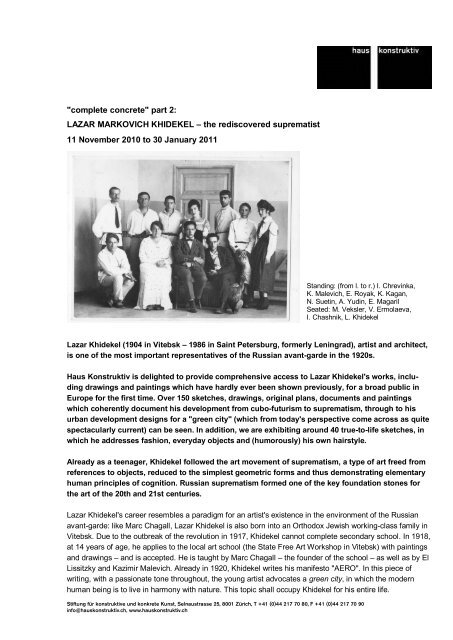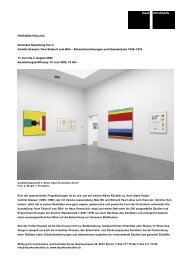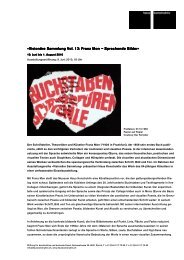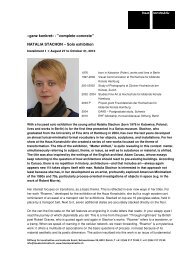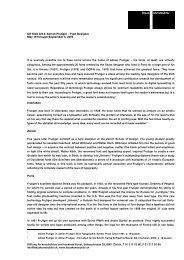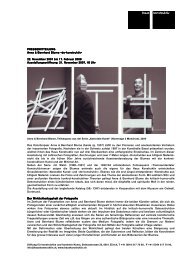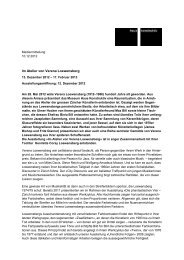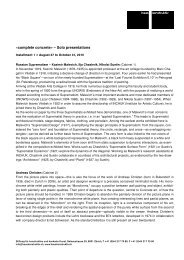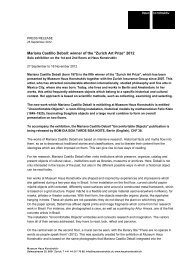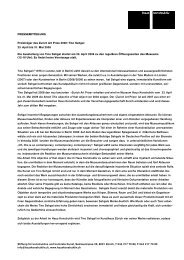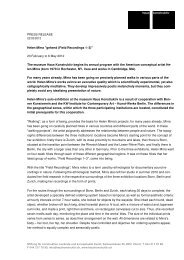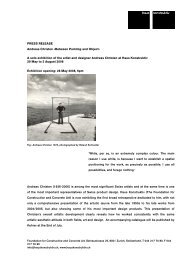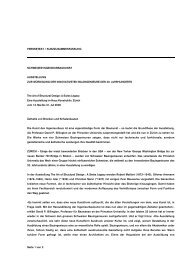part 2:LAZAR MARKOVICH KHIDEKEL - Museum Haus Konstruktiv
part 2:LAZAR MARKOVICH KHIDEKEL - Museum Haus Konstruktiv
part 2:LAZAR MARKOVICH KHIDEKEL - Museum Haus Konstruktiv
Create successful ePaper yourself
Turn your PDF publications into a flip-book with our unique Google optimized e-Paper software.
"complete concrete" <strong>part</strong> 2:<strong>LAZAR</strong> <strong>MARKOVICH</strong> <strong>KHIDEKEL</strong> – the rediscovered suprematist11 November 2010 to 30 January 2011Standing: (from l. to r.) I. Chrevinka,K. Malevich, E. Royak, K. Kagan,N. Suetin, A. Yudin, E. MagarilSeated: M. Veksler, V. Ermolaeva,I. Chashnik, L. KhidekelLazar Khidekel (1904 in Vitebsk – 1986 in Saint Petersburg, formerly Leningrad), artist and architect,is one of the most important representatives of the Russian avant-garde in the 1920s.<strong>Haus</strong> <strong>Konstruktiv</strong> is delighted to provide comprehensive access to Lazar Khidekel's works, includingdrawings and paintings which have hardly ever been shown previously, for a broad public inEurope for the first time. Over 150 sketches, drawings, original plans, documents and paintingswhich coherently document his development from cubo-futurism to suprematism, through to hisurban development designs for a "green city" (which from today's perspective come across as quitespectacularly current) can be seen. In addition, we are exhibiting around 40 true-to-life sketches, inwhich he addresses fashion, everyday objects and (humorously) his own hairstyle.Already as a teenager, Khidekel followed the art movement of suprematism, a type of art freed fromreferences to objects, reduced to the simplest geometric forms and thus demonstrating elementaryhuman principles of cognition. Russian suprematism formed one of the key foundation stones forthe art of the 20th and 21st centuries.Lazar Khidekel's career resembles a paradigm for an artist's existence in the environment of the Russianavant-garde: like Marc Chagall, Lazar Khidekel is also born into an Orthodox Jewish working-class family inVitebsk. Due to the outbreak of the revolution in 1917, Khidekel cannot complete secondary school. In 1918,at 14 years of age, he applies to the local art school (the State Free Art Workshop in Vitebsk) with paintingsand drawings – and is accepted. He is taught by Marc Chagall – the founder of the school – as well as by ElLissitzky and Kazimir Malevich. Already in 1920, Khidekel writes his manifesto "AERO". In this piece ofwriting, with a passionate tone throughout, the young artist advocates a green city, in which the modernhuman being is to live in harmony with nature. This topic shall occupy Khidekel for his entire life.Stiftung für konstruktive und konkrete Kunst, Selnaustrasse 25, 8001 Zürich, T +41 (0)44 217 70 80, F +41 (0)44 217 70 90info@hauskonstruktiv.ch, www.hauskonstruktiv.ch
Biography (short version)1904 Born in Vitebsk.1918 Admission to the art school in Vitebsk.1919 Studies under Marc Chagall (among others) and later El Lissitzky and Kazimir Malevich.1920-22 Member of the group UNOVIS (Champions of the New Art) under the leadership ofKazimir Malevich.Editor and designer of the periodical "AERO. Articles and Projects" (together with IlyaChashnik).1922 Khidekel graduates from the art school in Vitebsk renamed to the Vitebsk Practical ArtInstitute Khidekel follows Malevich to St. Petersburg.1924 Studies architecture at the Institute of Civil Engineering in Leningrad (LIGI).First suprematist architecture projects appear: Aero-Cities, City on the Pillars, City OverWater and Garden-City.1929 Khidekel receives his degree in architecture from LIGI.Together with A. Nikolsky, Khidekel designs the Cooperative Institute in Moscow.1930-1940 Khidekel works as an architect at the Leningrad Urban Planning Institute and teachesarchitecture at LIGI (until 1986).In the 1930s, although Khidekel sees himself confronted with classicism in architecture, hepursues suprematist theories in his work, right up until his death. He realises numerousprojects, e.g. a radio studio, various cooperatives, the Red Banner House of Culture andMoscow's first triplex cinema. Drawings, photographic works, plans and many designs areproduced.During the Second World War, GIPROMEZ, a new leading architectural institute whereKhidekel develops new technical methods, is founded in Sverdlovsk (Ukraine).1950-1960 Khidekel is called upon to <strong>part</strong>icipate in a national competition for a Stalin memorial inMoscow. He takes <strong>part</strong> in the competition and draws up a series of designs for a museum inhonour of Konstantin Tsiolkovsky, founder of cosmonautics.The reflection on cosmic themes inspires Khidekel to enter a post-suprematist period in hiswork.1986 Lazar Khidekel dies on 22 November in Leningrad.Solo exhibition (selection)1995 Suprematism and Architecture, Leonard Hutton Galleries, New York.2004 Surviving Suprematism: Lazar Khidekel, Judah L. Magnes <strong>Museum</strong>, Berkeley CAGroup exhibitions (selection)1919 First State Exhibition of Local and Moscow Artists with Chagall, Kandinsky,Malevich, Lissitzky and Rodchenko, among others.1920 UNOVISIn July, his works are exhibited at the First All-Russian Conference of Teachers andStudents of Art Schools in Moscow.1922 First Russian Art Exhibition in Berlin.1923 Works of Petrograd Artists of All Trends, 1918 – 1923.1927 First Exhibition of Contemporary Architecture organised by the magazine "S.A. theConstructivist magazine of contemporary architecture".1992 The Great Utopia The Russian and Soviet Avant-Garde 1915-1932Solomon Guggenheim <strong>Museum</strong>, State Tretiakov Gallery, State Russian <strong>Museum</strong>,Schirn Kunsthalle FrankfurtStiftung für konstruktive und konkrete Kunst, Selnaustrasse 25, 8001 Zürich, T +41 (0)44 217 70 80, F +41 (0)44 217 70 90info@hauskonstruktiv.ch, www.hauskonstruktiv.ch
1994 Europa, EuropaDas Jahrhundert Der Avantgarde In Mittel-und OsteuropaKunst-und Ausstellungshalle der Bundesrepublik Deutschland1995 Kasimir Malewitsch. Werk and Wirkung, <strong>Museum</strong> Ludwig Cologne1996 Russian Jewish Artists in a Century of Change 1890-1990,The Jewish <strong>Museum</strong>, NY2000 Malevich’s CircleConfederates. Students. Followers in Russia 1920sw-1950sThe State Russian <strong>Museum</strong>, St. Petersburg2002 Russian Revolutions: Generations of Russian Jewish Avant-Garde ArtistsSinger Gallery, Mizel Center for Arts and Culture, Denver, CO2007 A World of Stage: Russian Designs for Theater, Opera, and Dance, Japan2009 Homage to Diaghilev’s Enduring Legacy, Columbia UniversityStiftung für konstruktive und konkrete Kunst, Selnaustrasse 25, 8001 Zürich, T +41 (0)44 217 70 80, F +41 (0)44 217 70 90info@hauskonstruktiv.ch, www.hauskonstruktiv.ch


